Page 298 of 570
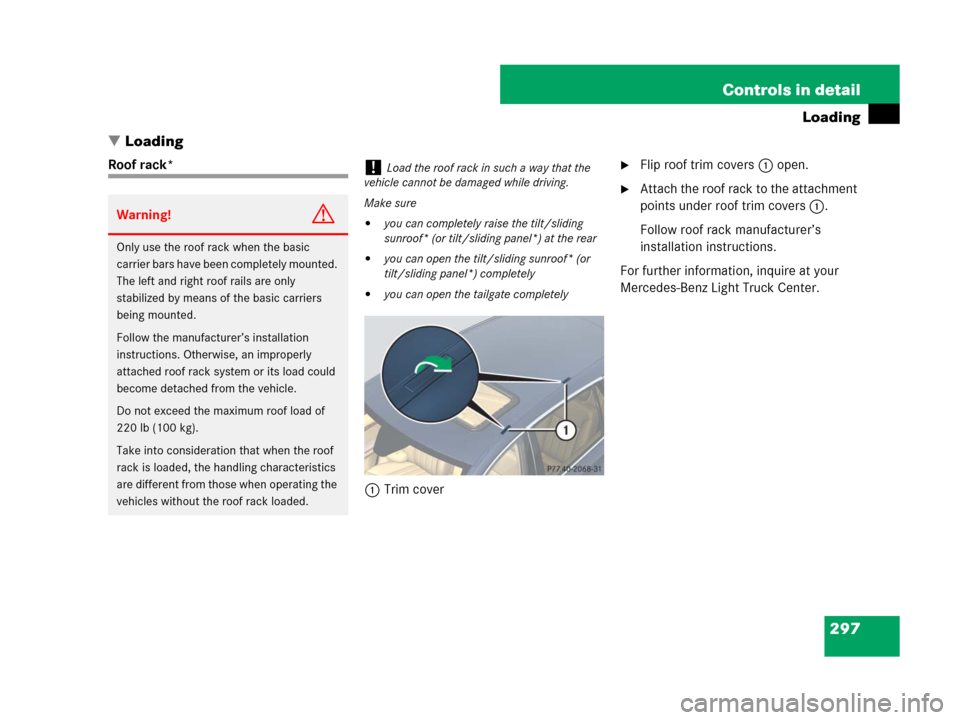
297 Controls in detail
Loading
�Loading
Roof rack*
1Trim cover�Flip roof trim covers 1 open.
�Attach the roof rack to the attachment
points under roof trim covers 1.
Follow roof rack manufacturer’s
installation instructions.
For further information, inquire at your
Mercedes-Benz Light Truck Center.
Warning!G
Only use the roof rack when the basic
carrier bars have been completely mounted.
The left and right roof rails are only
stabilized by means of the basic carriers
being mounted.
Follow the manufacturer’s installation
instructions. Otherwise, an improperly
attached roof rack system or its load could
become detached from the vehicle.
Do not exceed the maximum roof load of
220 lb (100 kg).
Take into consideration that when the roof
rack is loaded, the handling characteristics
are different from those when operating the
vehicles without the roof rack loaded.
!Load the roof rack in such a way that the
vehicle cannot be damaged while driving.
Make sure
�you can completely raise the tilt/sliding
sunroof* (or tilt/sliding panel*) at the rear
�you can open the tilt/sliding sunroof* (or
tilt/sliding panel*) completely
�you can open the tailgate completely
Page 299 of 570
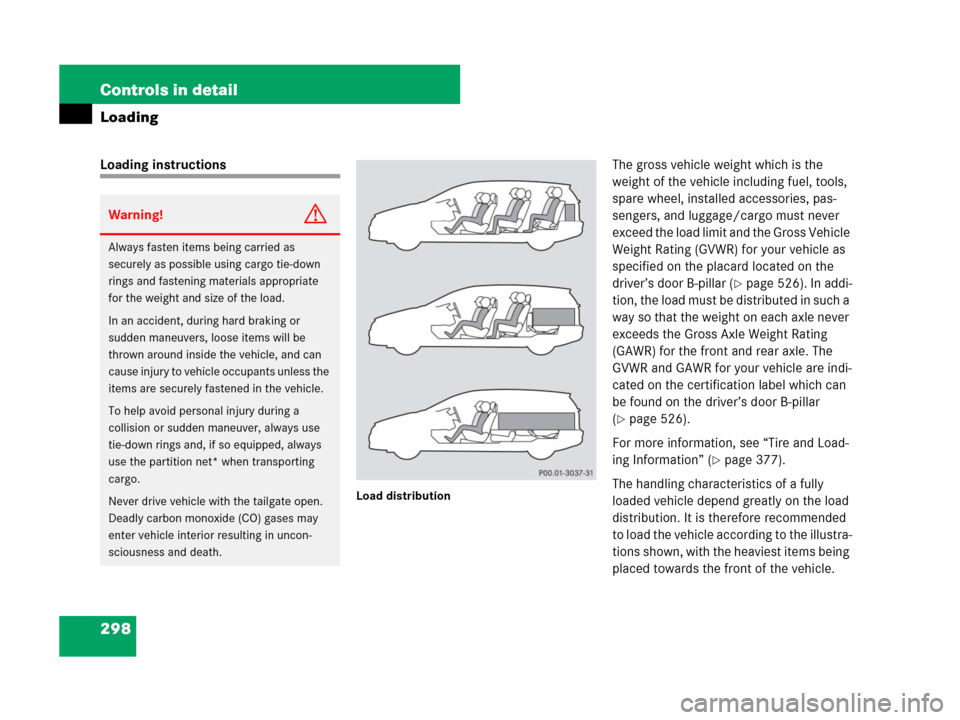
298 Controls in detail
Loading
Loading instructions
Load distribution
The gross vehicle weight which is the
weight of the vehicle including fuel, tools,
spare wheel, installed accessories, pas-
sengers, and luggage/cargo must never
exceed the load limit and the Gross Vehicle
Weight Rating (GVWR) for your vehicle as
specified on the placard located on the
driver’s door B-pillar (
�page 526). In addi-
tion, the load must be distributed in such a
way so that the weight on each axle never
exceeds the Gross Axle Weight Rating
(GAWR) for the front and rear axle. The
GVWR and GAWR for your vehicle are indi-
cated on the certification label which can
be found on the driver’s door B-pillar
(
�page 526).
For more information, see “Tire and Load-
ing Information” (
�page 377).
The handling characteristics of a fully
loaded vehicle depend greatly on the load
distribution. It is therefore recommended
to load the vehicle according to the illustra-
tions shown, with the heaviest items being
placed towards the front of the vehicle.
Warning!G
Always fasten items being carried as
securely as possible using cargo tie-down
rings and fastening materials appropriate
for the weight and size of the load.
In an accident, during hard braking or
sudden maneuvers, loose items will be
thrown around inside the vehicle, and can
cause injury to vehicle occupants unless the
items are securely fastened in the vehicle.
To help avoid personal injury during a
collision or sudden maneuver, always use
tie-down rings and, if so equipped, always
use the partition net* when transporting
cargo.
Never drive vehicle with the tailgate open.
Deadly carbon monoxide (CO) gases may
enter vehicle interior resulting in uncon-
sciousness and death.
Page 302 of 570
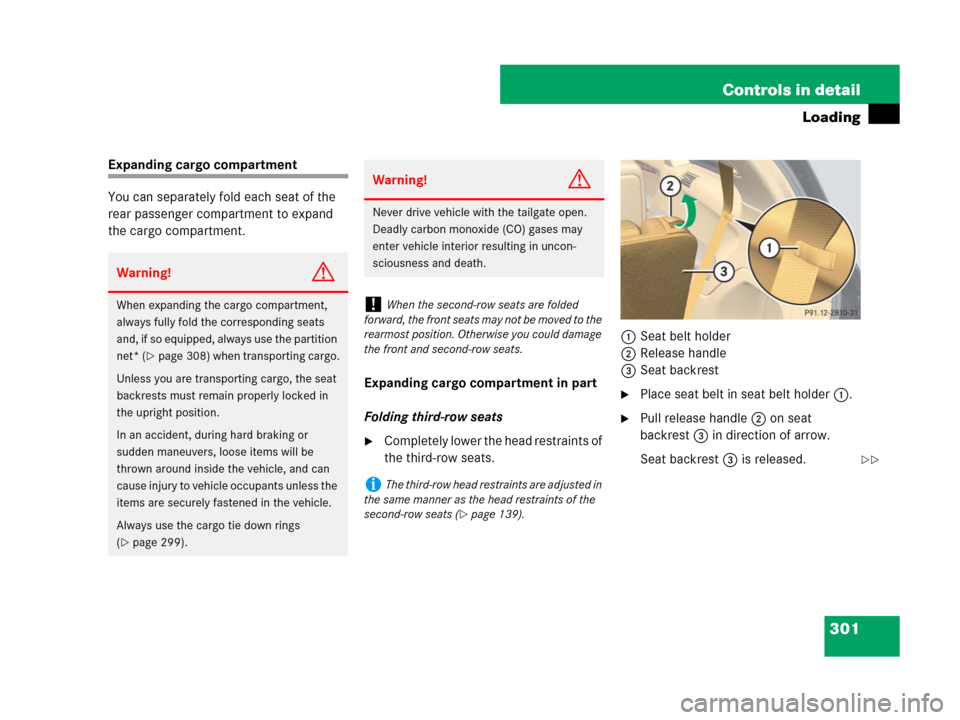
301 Controls in detail
Loading
Expanding cargo compartment
You can separately fold each seat of the
rear passenger compartment to expand
the cargo compartment.
Expanding cargo compartment in part
Folding third-row seats
�Completely lower the head restraints of
the third-row seats.1Seat belt holder
2Release handle
3Seat backrest
�Place seat belt in seat belt holder 1.
�Pull release handle 2 on seat
backrest3 in direction of arrow.
Seat backrest 3 is released.
Warning!G
When expanding the cargo compartment,
always fully fold the corresponding seats
and, if so equipped, always use the partition
net* (
�page 308) when transporting cargo.
Unless you are transporting cargo, the seat
backrests must remain properly locked in
the upright position.
In an accident, during hard braking or
sudden maneuvers, loose items will be
thrown around inside the vehicle, and can
cause injury to vehicle occupants unless the
items are securely fastened in the vehicle.
Always use the cargo tie down rings
(
�page 299).
Warning!G
Never drive vehicle with the tailgate open.
Deadly carbon monoxide (CO) gases may
enter vehicle interior resulting in uncon-
sciousness and death.
!When the second-row seats are folded
forward, the front seats may not be moved to the
rearmost position. Otherwise you could damage
the front and second-row seats.
iThe third-row head restraints are adjusted in
the same manner as the head restraints of the
second-row seats (
�page 139).
��
Page 303 of 570
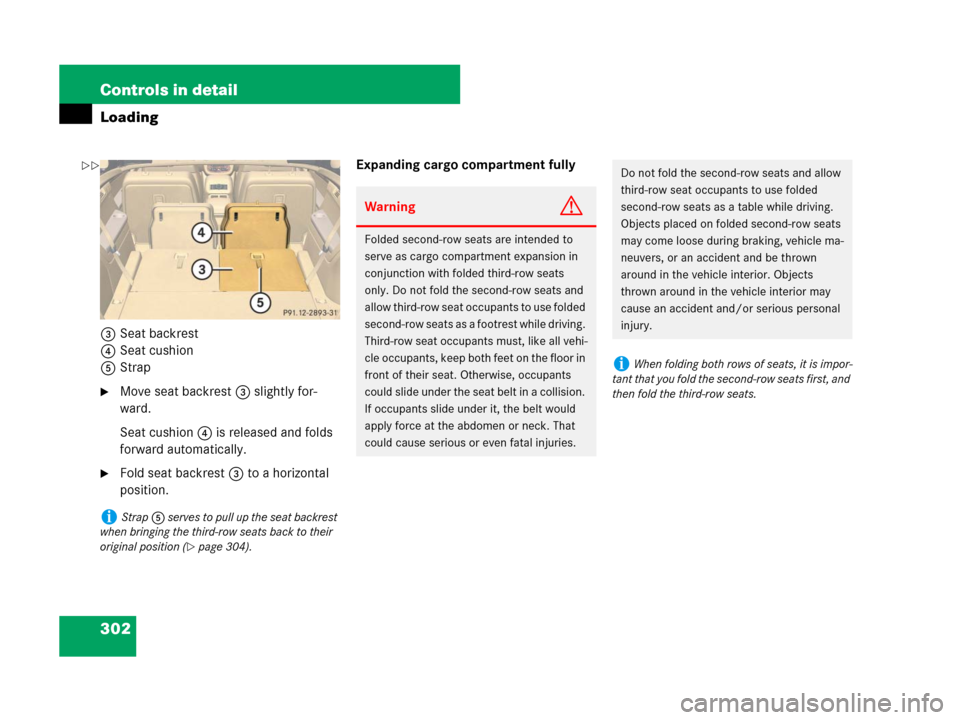
302 Controls in detail
Loading
3Seat backrest
4Seat cushion
5Strap
�Move seat backrest 3 slightly for-
ward.
Seat cushion 4 is released and folds
forward automatically.
�Fold seat backrest 3 to a horizontal
position.Expanding cargo compartment fully
iStrap 5 serves to pull up the seat backrest
when bringing the third-row seats back to their
original position (
�page 304).
WarningG
Folded second-row seats are intended to
serve as cargo compartment expansion in
conjunction with folded third-row seats
only. Do not fold the second-row seats and
allow third-row seat occupants to use folded
second-row seats as a footrest while driving.
Third-row seat occupants must, like all vehi-
cle occupants, keep both feet on the floor in
front of their seat. Otherwise, occupants
could slide under the seat belt in a collision.
If occupants slide under it, the belt would
apply force at the abdomen or neck. That
could cause serious or even fatal injuries.
Do not fold the second-row seats and allow
third-row seat occupants to use folded
second-row seats as a table while driving.
Objects placed on folded second-row seats
may come loose during braking, vehicle ma-
neuvers, or an accident and be thrown
around in the vehicle interior. Objects
thrown around in the vehicle interior may
cause an accident and/or serious personal
injury.
iWhen folding both rows of seats, it is impor-
tant that you fold the second-row seats first, and
then fold the third-row seats.
��
Page 306 of 570
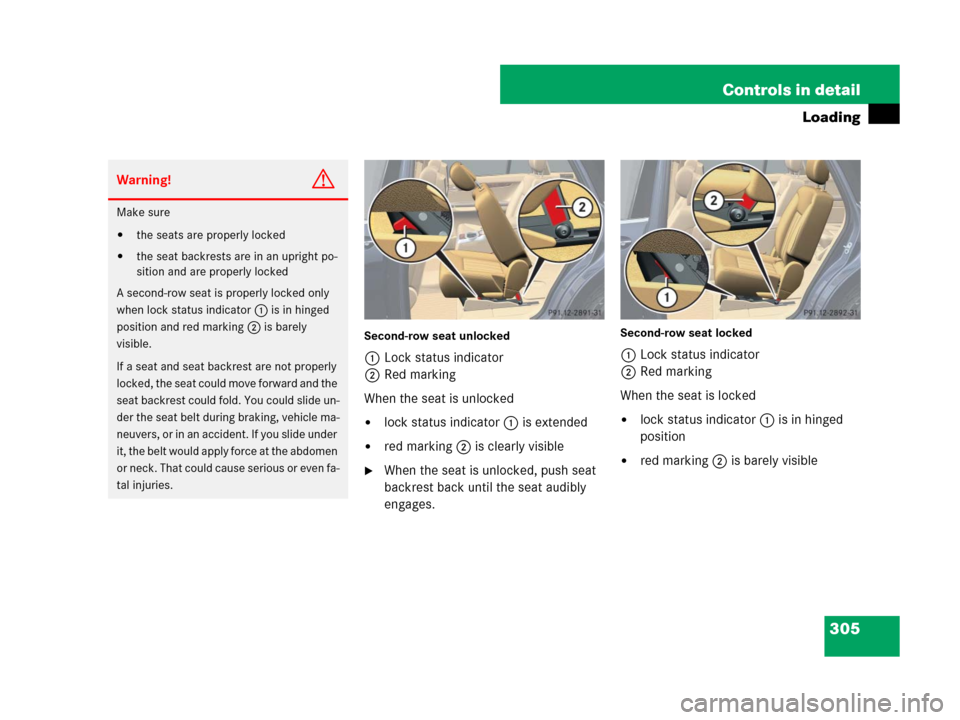
305 Controls in detail
Loading
Second-row seat unlocked
1Lock status indicator
2Red marking
When the seat is unlocked
�lock status indicator 1 is extended
�red marking 2 is clearly visible
�When the seat is unlocked, push seat
backrest back until the seat audibly
engages.
Second-row seat locked
1Lock status indicator
2Red marking
When the seat is locked
�lock status indicator 1 is in hinged
position
�red marking 2 is barely visible
Warning!G
Make sure
�the seats are properly locked
�the seat backrests are in an upright po-
sition and are properly locked
A second-row seat is properly locked only
when lock status indicator 1 is in hinged
position and red marking 2 is barely
visible.
If a seat and seat backrest are not properly
locked, the seat could move forward and the
seat backrest could fold. You could slide un-
der the seat belt during braking, vehicle ma-
neuvers, or in an accident. If you slide under
it, the belt would apply force at the abdomen
or neck. That could cause serious or even fa-
tal injuries.
Page 309 of 570
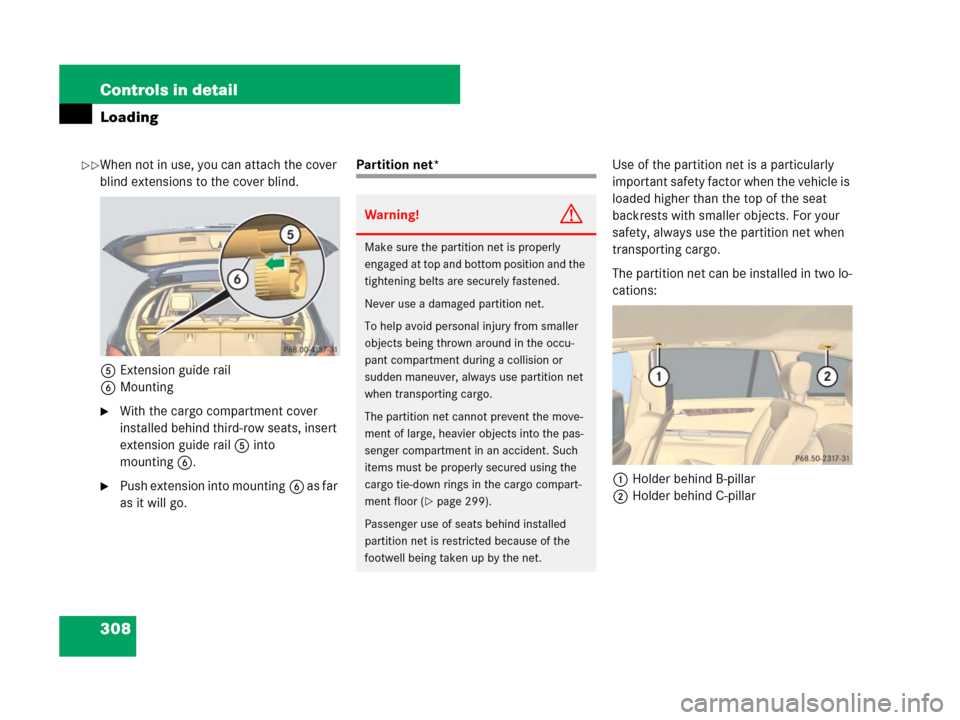
308 Controls in detail
Loading
When not in use, you can attach the cover
blind extensions to the cover blind.
5Extension guide rail
6Mounting
�With the cargo compartment cover
installed behind third-row seats, insert
extension guide rail 5 into
mounting6.
�Push extension into mounting6 as far
as it will go.
Partition net*Use of the partition net is a particularly
important safety factor when the vehicle is
loaded higher than the top of the seat
backrests with smaller objects. For your
safety, always use the partition net when
transporting cargo.
The partition net can be installed in two lo-
cations:
1Holder behind B-pillar
2Holder behind C-pillar
Warning!G
Make sure the partition net is properly
engaged at top and bottom position and the
tightening belts are securely fastened.
Never use a damaged partition net.
To help avoid personal injury from smaller
objects being thrown around in the occu-
pant compartment during a collision or
sudden maneuver, always use partition net
when transporting cargo.
The partition net cannot prevent the move-
ment of large, heavier objects into the pas-
senger compartment in an accident. Such
items must be properly secured using the
cargo tie-down rings in the cargo compart-
ment floor (
�page 299).
Passenger use of seats behind installed
partition net is restricted because of the
footwell being taken up by the net.
��
Page 312 of 570
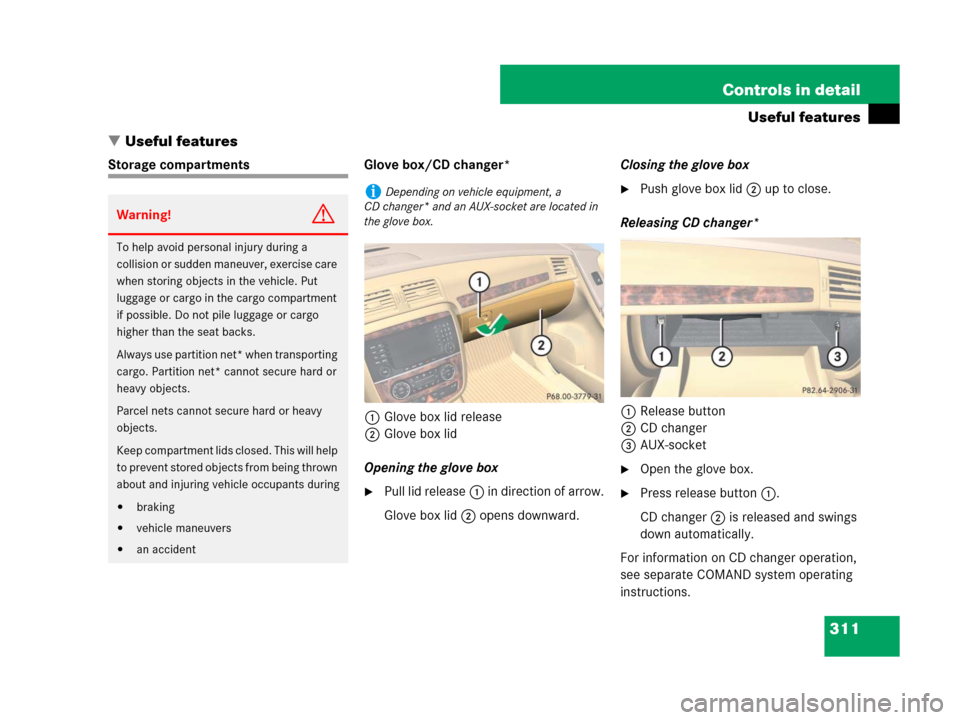
311 Controls in detail
Useful features
�Useful features
Storage compartments Glove box/CD changer*
1Glove box lid release
2Glove box lid
Opening the glove box
�Pull lid release1 in direction of arrow.
Glove box lid2 opens downward.Closing the glove box
�Push glove box lid 2 up to close.
Releasing CD changer*
1Release button
2CD changer
3AUX-socket
�Open the glove box.
�Press release button 1.
CD changer 2 is released and swings
down automatically.
For information on CD changer operation,
see separate COMAND system operating
instructions.
Warning!G
To help avoid personal injury during a
collision or sudden maneuver, exercise care
when storing objects in the vehicle. Put
luggage or cargo in the cargo compartment
if possible. Do not pile luggage or cargo
higher than the seat backs.
Always use partition net* when transporting
cargo. Partition net* cannot secure hard or
heavy objects.
Parcel nets cannot secure hard or heavy
objects.
Keep compartment lids closed. This will help
to prevent stored objects from being thrown
about and injuring vehicle occupants during
�braking
�vehicle maneuvers
�an accident
iDepending on vehicle equipment, a
CD changer* and an AUX-socket are located in
the glove box.
Page 316 of 570
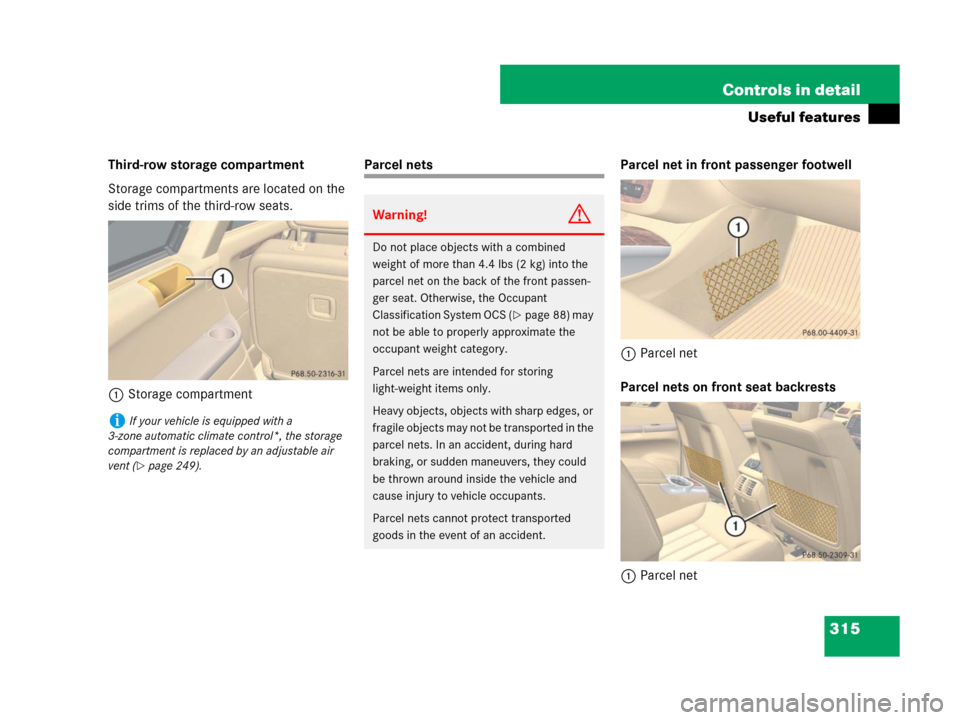
315 Controls in detail
Useful features
Third-row storage compartment
Storage compartments are located on the
side trims of the third-row seats.
1Storage compartmentParcel nets Parcel net in front passenger footwell
1Parcel net
Parcel nets on front seat backrests
1Parcel net
iIf your vehicle is equipped with a
3-zone automatic climate control*, the storage
compartment is replaced by an adjustable air
vent (
�page 249).
Warning!G
Do not place objects with a combined
weight of more than 4.4 lbs (2 kg) into the
parcel net on the back of the front passen-
ger seat. Otherwise, the Occupant
Classification System OCS (
�page 88) may
not be able to properly approximate the
occupant weight category.
Parcel nets are intended for storing
light-weight items only.
Heavy objects, objects with sharp edges, or
fragile objects may not be transported in the
parcel nets. In an accident, during hard
braking, or sudden maneuvers, they could
be thrown around inside the vehicle and
cause injury to vehicle occupants.
Parcel nets cannot protect transported
goods in the event of an accident.